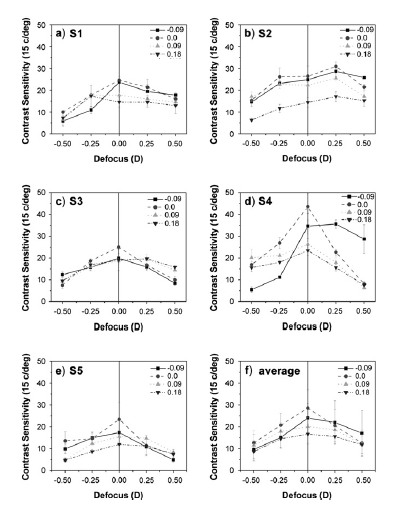Purpose: To explore the impact of spherical aberration (SA) on contrast sensitivity using an adaptive optics vision simulator to determine the optimal amount of SA to include in customized corrections of wavefront aberrations.
Methods: An adaptive optics vision simulator consisting of a wavefront sensor, a 97-segmented deformable mirror to induce and correct aberrations of the eye, and a visual testing path was constructed for this study. The deformable mirror allows the effective ocular wavefront aberration to be manipulated and the resulting visual performance to be measured simultaneously. Subjective measurements of contrast sensitivity at 15 cycles per degree were performed with a 4.8 mm pupil in 5 subjects with different levels of naturally occurring SA. Contrast sensitivity was measured when SA values of -0.09 mm, 0.0 mm, 0.09 mm, and 0.182 mm were induced when the other natural aberrations of the eye were present, when the aberrations were corrected, and at defocus values of G0.25 diopter (D) and G0.50 D.
Results: Subjects experienced peak contrast sensitivity performance with varying levels of SA when their natural aberrations were present; however, average contrast performance peaked at 0 mm of SA. When all higher-order aberrations were corrected, all 5 subjects’ peak performance occurred at 0 mm of SA.
Conclusions: The adaptive optics vision simulator reduced the root-mean-square wavefront aberration of the eye by up to a factor of 4 and allowed noninvasive testing of the visual performance resulting from any ocular wavefront aberration introduced by customized correction procedures. This study showed that, on average, contrast performance peaked when SA was completely corrected.
Buscar
Categorías
Archivos
- junio 2025 (2)
- mayo 2025 (1)
- marzo 2025 (2)
- diciembre 2024 (4)
- octubre 2024 (5)
- septiembre 2024 (1)
- julio 2024 (8)
- junio 2024 (1)
- mayo 2024 (1)
- marzo 2024 (1)
- octubre 2023 (2)
- julio 2023 (5)
- junio 2023 (1)
- julio 2022 (10)
- mayo 2022 (1)
- marzo 2022 (1)
- julio 2021 (5)
- marzo 2021 (2)
- octubre 2020 (36)
- septiembre 2020 (122)
- agosto 2020 (10)
- julio 2020 (38)
- abril 2020 (1)
- diciembre 2019 (1)
- abril 2018 (1)
- septiembre 2017 (2)

Use of adaptive optics to determine the optimal ocular spherical aberration
- Voptica
- Publicaciones de VAO
Journal:
Journal of Cataract & Refractive Surgery
Year:
2007
Link:
Authors:
Patricia A. Piers; Silvestre Manzanera; Pedro M. Prieto; Nicolas Gorceix; Pablo Artal